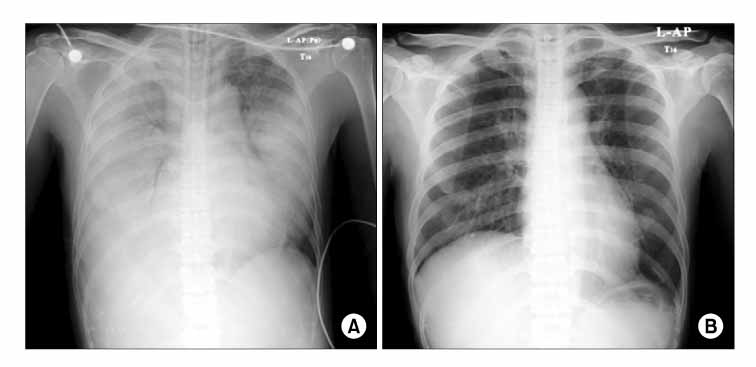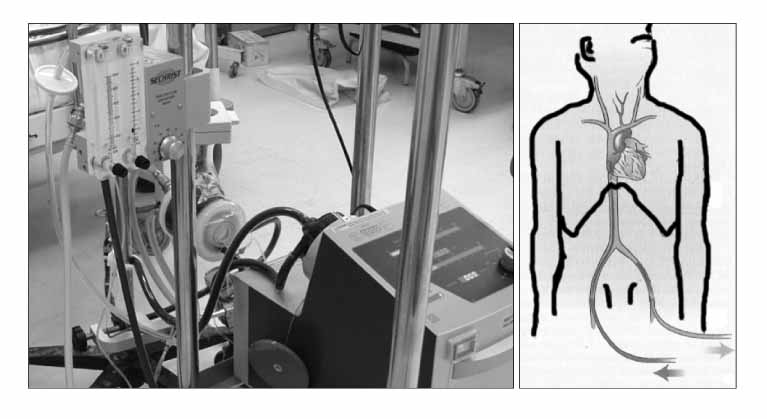Tuberc Respir Dis.
2007 Dec;63(6):526-530.
A Case of Severe Acute Respiratory Distress Syndrome Treated with Extracorporeal Life Support
- Affiliations
-
- 1Department of Internal Medicine, Hallym University School of Medicine, Chuncheon, Korea. mglee@hallym.or.kr
- 2Department of Thoracic and Cardiovascular Surgery, Hallym University School of Medicine, Chuncheon, Korea.
Abstract
- The incidence of acute respiratory distress syndrome (ARDS) has been estimated worldwide to range from 1.7 to 75 cases per 100,000. There are many treatments for ARDS, but only the low tidal volume strategy is based on strong clinical evidence from randomized clinical trials. The efficacy of extracorporeal life support (ECLS) in adults remains controversial. Ongoing clinical trials and research have shown a benefit for its use to salvage severe ARDS patients that are in failure with conventional treatment. We encountered a 41-year-old woman who developed ARDS induced by pneumococcal pneumonia. Despite conventional mechanical ventilation in the emergency room, severe hypoxia remained. We treated the patient immediately with ECLS. The patient has almost fully recovered, and was discharged from a 177-day stay at our hospital.
MeSH Terms
Figure
Reference
-
1. Wheeler AP, Bernard GR. Acute lung injury and the acute respiratory distress syndrome: a clinical review. Lancet. 2007. 369:1553–1564.2. Hemmila MR, Napolitano LM. Severe respiratory failure: advanced treatment options. Crit Care Med. 2006. 34:S278–S290.3. Zapol WM, Snider MT, Hill JD, Fallat RJ, Bartlett RH, Edmunds LH, et al. Extracorporeal membrane oxygenation in severe acute respiratory failure: a randomized prospective study. JAMA. 1979. 242:2193–2196.4. Morris AH, Wallace CJ, Menlove RL, Clemmer TP, Orme JF Jr, Weaver LK, et al. Randomized clinical trial of pressure-controlled inverse ratio ventilation and extracorporeal CO2 removal for acute respiratory distress syndrome. Am J Respir Crit Care Med. 1994. 149:295–305.5. Hemmila MR, Rowe SA, Boules TN, Miskulin J, McGillicuddy JW, Schuerer DJ, et al. Extracorporeal life support for severe acute respiratory distress syndrome in adults. Ann Surg. 2004. 240:595–607.6. Peek GJ, Clemens F, Elbourne D, Firmin R, Hardy P, Hibbert C, et al. CESAR: conventional ventilatory support vs extracorporeal membrane oxygenation for severe adult respiratory failure. BMC Health Serv Res. 2006. 6:163.7. Bernard GR, Artigas A, Brigham KL, Carlet J, Falke K, Hudson L, et al. The American-European Consensus Conference on ARDS. Definitions, mechanisms, relevant outcomes, and clinical trial coordination. Am J Respir Crit Care Med. 1994. 149:818–824.8. Scientific Subcommittee for National Survey of Acute Respiratory Distress Syndrome in Korean Academy of Tuberculosis and Respiratory Disease. The national survey of acute respiratory distress syndrome in Korea. Tuberc Respir Dis. 1997. 44:25–43.9. The National Heart, Lung, and Blood Institute Acute Respiratory Distress Syndrome (ARDS) Clinical Trials Network. Efficacy and safety of corticosteroids for persistent acute respiratory distress syndrome. N Engl J Med. 2006. 354:1671–1684.10. Amato MB, Barbas CS, Medeiros DM, magaldi RB, Schettino GP, Lorenzi-Filho G, et al. Effect of a protective-ventilation strategy on mortality in the acute respiratory distress syndrome. N Engl J Med. 1998. 338:347–354.11. ARDS Clinical Trials Network. Ventilation with lower tidal volumes as compared with traditional tidal volumes for acute lung injury and acute respiratory distress syndrome. N Engl J Med. 2000. 342:1301–1308.12. Bartlett RH, Roloff DW, Cornell RG, Andrews AF, Dillon PW, Zwischenberger JB. Extracorporeal circulation in neonatal respiratory failure: a prospective randomized study. Pediatrics. 1985. 76:479–487.13. Kopp R, Dembinski R, Kuhlen R. Role of extracorporeal lung assist in the treatment of acute respiratory failure. Minerva Anestesiol. 2006. 72:587–595.
- Full Text Links
- Actions
-
Cited
- CITED
-
- Close
- Share
- Similar articles
-
- The Treatment of Adult Respiratory Distress Syndrome (ARDS) Using Extracorporeal Membrane Oxygenation (ECMO)
- Treatment of acute respiratory failure: extracorporeal membrane oxygenation
- Update on the Extracorporeal Life Support
- A 35-month-old boy who ingested laundry detergent pods and underwent veno-pulmonary extracorporeal membrane oxygenation support
- Recovery from Acute Respiratory Distress Syndrome with Long-Run Extracorporeal Membrane Oxygenation




